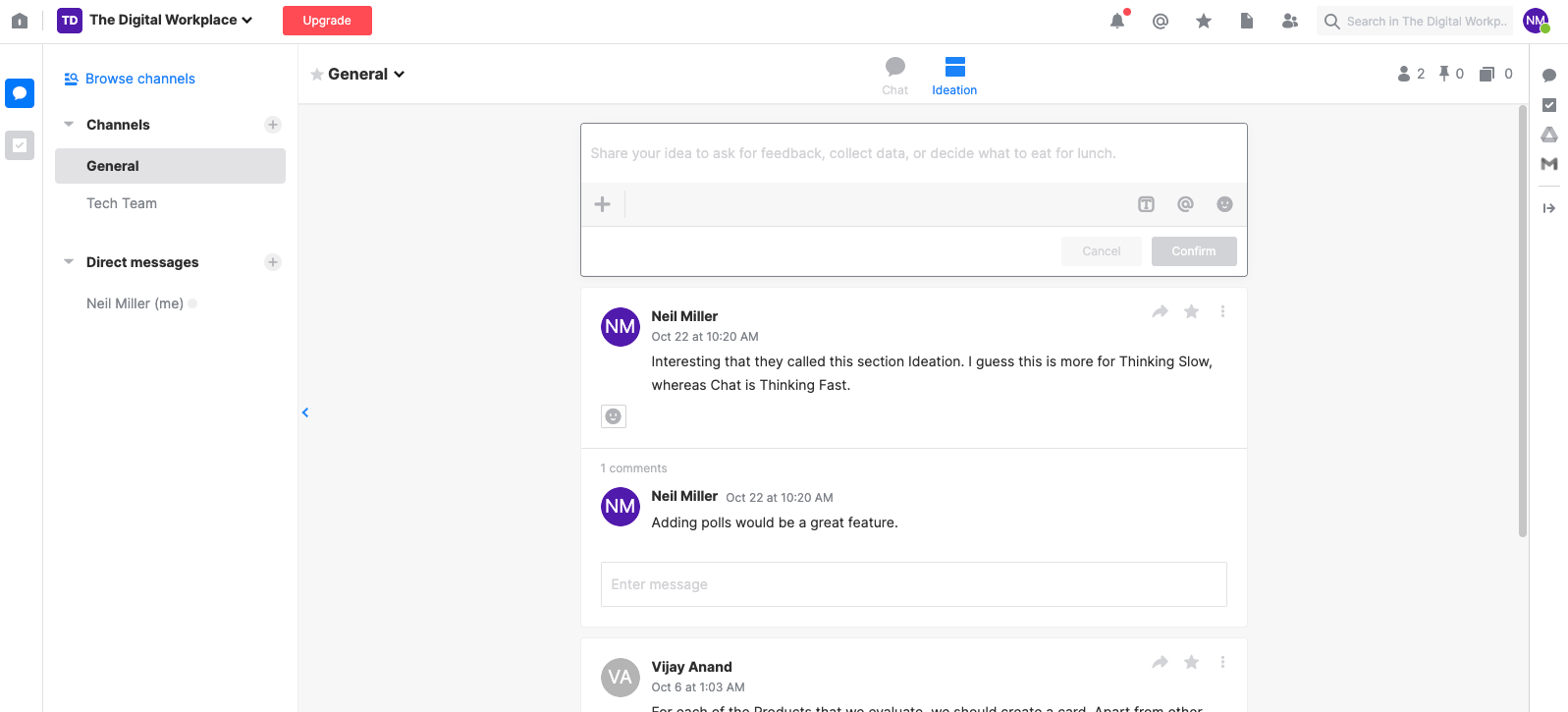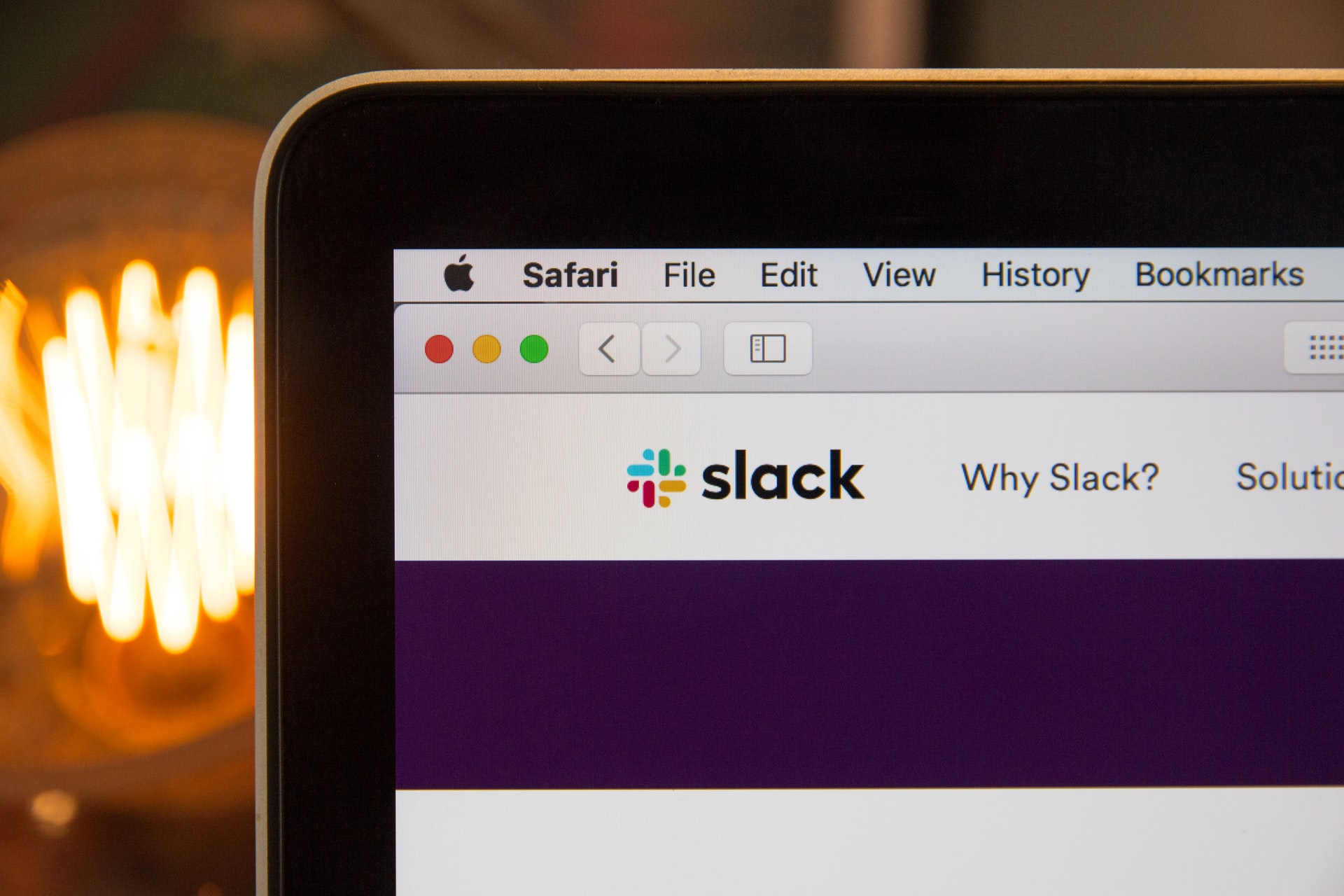“There’s no way my team can be innovative on Zoom calls.”
You said it. Your last boss said it. Everyone you know said it.
And everyone is right, more or less.
When leaders think about innovation, they imagine high-intensity collaboration. Innovation is the look of a blank whiteboard, the sound of opening a pack of sticky notes, and the smell of brand new dry erase markers.
Innovation means organic and often spontaneous encounters in a physical location. It happens when you stay late and order Chinese food.
A digital workplace seems to be at odds with a truly innovative company. Digital workplaces are planned and intentional. They default to leaving people alone.
In a study from Atlassian and PaperGiant, 28% of respondents believed there were fewer or worse collaboration opportunities in remote setups. Digital workplaces seem to limit “serendipitous encounters that spark new ideas”.
Is there any room left for a digital innovation process?
Innovation is a process, not a meeting
Let’s start by redefining what we need from work. We associate innovation with a moment when someone has a brilliant idea that others quickly build on.
But broadly speaking, innovation is finding a new solution to an old problem. It’s not a moment, and it’s not a meeting.
Innovation experts say there are three distinct phases of innovation.
- Correctly identify the problem (discovery)
- Generating a lot of ideas (evaluation)
- Selecting the ideas you think have the best chance of succeeding (execution)
Disadvantages of the traditional approach to innovation
The classic approach to innovation involves a set space and time. You book a conference room or plan an offsite. You lock people in a room, hire a facilitator, and assume the magic will happen.
Tomasz Tunguz points out a few inherent problems with traditional ‘brainstorming’ meetings.
- Only one person can speak at a time.
- Many people don’t participate.
- Some people have a fear of speaking in public and won’t talk even if they have something important to share.
Here are more inherent problems that office-centric innovation must overcome.
- There is a limited number of people. You might not have invited the person with the best idea because there wasn’t space in the room or budget.
- Live meetings only accommodate fast thinking. They assume slow thinking will happen elsewhere.
- Meetings are dominated by those who are verbal processors, quick-thinking, and loud.
- You can’t control what happens right before people enter the meeting. Some may come in very prepared while others are frazzled and bothered by something else.
Native advantages of the digital innovation process
While not perfect, innovation in a digital workplace has some distinct advantages.
- You can involve any number of people in the process and scale it up and down quickly.
- You can easily create time for both slow and fast thinking.
- It allows people who are textual processors to have an equal impact.
- You can spread out the innovation process without needing to book an offsite for an entire week.
What the digital innovation process can look like
Here’s an idea of what the complete innovation process can look like in a digital environment. Notice that this example doesn’t require a live meeting of more than four people.
1. Identify the issue you think you are dealing with. Write up a few paragraphs to give the necessary context. Prepare a recorded video to present the challenge.
2. Determine who you want to be a part of the innovation process. Share the video and context document with them. Ask people to leave comments on the document (or give feedback in a form) over the next few days.
3. Pair people up in 1:1 live meetings so they can process their thoughts out loud with someone else.
4. Review the notes that everyone has sent in and consolidate the responses.
5. Have groups of four meet live to discuss the results. Each group records if you’ve accurately identified the problem.
6. Announce that you want people to come up with lots of ideas over the next week. You are only collecting ideas, not voting on them. Post ideas in a public forum since one idea might cause someone else to iterate something better. Consider having another round of 1:1 meetings where people come up with ideas in pairs.
7. Consolidate all the ideas and put them in a tool to allow for voting and commenting. Find tools that have ranked choice voting so that people can highlight the ideas they think are best.
8. Take the clear favorites that stand out. Have new groups of four meet again to discuss which ideas should be acted on.
9. Host a live stream where you announce which ideas you are going to try. Give the full context to what swayed you.
10. After the live stream, have people get in groups of two or three to give their final reflections.
This is an example of a complete innovation process. But innovation doesn’t always have to be so planned and drawn out. Simple solutions as mentioned below can also cause spontaneous innovation.
Live interactions are still important for innovation
Live collaboration is an essential part of the digital innovation process. Here are great uses of the live meeting.
Get a read on body language. People will show their emotions through their body much before their words. A live meeting will let you see where someone is hesitating or isn’t committed.
Give a change of scenery. Getting out of the house/co-working space/office is still a great tool to generate fresh ideas. Consider hosting one of your meetings live in a new venue.
Get instant feedback. There’s a big difference between instant admiration for a new plan and watching people slowly fall in line over a few days. A live event gives the presenter that quick reaction. Don’t rely on this reaction exclusively, but it is valuable.
Promote super-fast collaboration. Even the tiniest bit of latency can be enough to make you feel like you are stepping on others toes. Some ideas develop best like a friction fire. A spark happens and quickly bounces back and forth between several people until there’s a full flame. If you have a great idea, you want to be able to run into your bestie’s office and share it immediately. Ideas lose momentum when you send a Slack message and wait for an hour or more for a response.
Bonus tips for digital innovation
Skip the video call
When you are apart, audio is the best way to connect. While video gives additional signals to read, it is also tiring. You are making fake eye contact, and are easily distracted by your own video and everything else on the screen.
Audio calls also let you change your scenery. You can go for a walk or take a drive.
When that brilliant idea comes, a phone call is better than trying to catch someone on video or chat.
Audio notes
The majority of communication in a digital workplace is textual. But this is not very inclusive. You may have people on your team who aren’t as good at writing or aren’t comfortable with your common language. Allowing for audio notes and comments makes it easier for everyone.
Make use of meeting technology
There’s a lot of virtual meeting tools out there which make collaboration and innovation in a digital workplace much easier.
Working in public
The same Atlassian report mentioned above said that participants “lamented organic encounters of others’ work, once pinned to walls or left on desks, which made them open to comment and improvement.” The lack of a shared visual space to display work makes it hard to think outside of your own silo. Develop a habit of working in public, sharing wins, and giving people access to documents by default.
Have the meeting a second time
There’s a lot of pressure on innovation meetings. You often leave thinking, “Did we really just decide to relocate the company to Jersey?”
Consider having a repeat meeting or doing one of the processes again, especially if your answer is leaving some people feeling uneasy. This gives your brain a chance to evaluate the ideas from a different angle. If you come up with the same answer, you can have more confidence.
Practice innovation before you need it
You don’t want to wait to flex your innovation muscle until you really need it. Host quarterly or yearly events that allow people to get used to the innovation process. Let everyone identify a problem in the organization and come up with a solution. This kind of practice will make it easier when the stakes are high.
The digital innovation process is achievable
Innovation on Zoom calls is possible, just not in the way you thought it was going to be. The digital innovation process can be more inclusive, encourage both slow and fast thinking, and doesn’t abandon live collaboration.
With the right preparation and a steady hand, digital innovation doesn’t have to be a myth.
“There’s no way my team can be innovative on Zoom calls.”
You said it. Your last boss said it. Everyone you know said it.
And everyone is right, more or less.
When leaders think about innovation, they imagine high-intensity collaboration. Innovation is the look of a blank whiteboard, the sound of opening a pack of sticky notes, and the smell of brand new dry erase markers.
Innovation means organic and often spontaneous encounters in a physical location. It happens when you stay late and order Chinese food.
A digital workplace seems to be at odds with a truly innovative company. Digital workplaces are planned and intentional. They default to leaving people alone.
In a study from Atlassian and PaperGiant, 28% of respondents believed there were fewer or worse collaboration opportunities in remote setups. Digital workplaces seem to limit “serendipitous encounters that spark new ideas”.
Is there any room left for a digital innovation process?
Innovation is a process, not a meeting
Let’s start by redefining what we need from work. We associate innovation with a moment when someone has a brilliant idea that others quickly build on.
But broadly speaking, innovation is finding a new solution to an old problem. It’s not a moment, and it’s not a meeting.
Innovation experts say there are three distinct phases of innovation.
- Correctly identify the problem (discovery)
- Generating a lot of ideas (evaluation)
- Selecting the ideas you think have the best chance of succeeding (execution)
Disadvantages of the traditional approach to innovation
The classic approach to innovation involves a set space and time. You book a conference room or plan an offsite. You lock people in a room, hire a facilitator, and assume the magic will happen.
Tomasz Tunguz points out a few inherent problems with traditional ‘brainstorming’ meetings.
- Only one person can speak at a time.
- Many people don’t participate.
- Some people have a fear of speaking in public and won’t talk even if they have something important to share.
Here are more inherent problems that office-centric innovation must overcome.
- There is a limited number of people. You might not have invited the person with the best idea because there wasn’t space in the room or budget.
- Live meetings only accommodate fast thinking. They assume slow thinking will happen elsewhere.
- Meetings are dominated by those who are verbal processors, quick-thinking, and loud.
- You can’t control what happens right before people enter the meeting. Some may come in very prepared while others are frazzled and bothered by something else.
Native advantages of the digital innovation process
While not perfect, innovation in a digital workplace has some distinct advantages.
- You can involve any number of people in the process and scale it up and down quickly.
- You can easily create time for both slow and fast thinking.
- It allows people who are textual processors to have an equal impact.
- You can spread out the innovation process without needing to book an offsite for an entire week.
What the digital innovation process can look like
Here’s an idea of what the complete innovation process can look like in a digital environment. Notice that this example doesn’t require a live meeting of more than four people.
1. Identify the issue you think you are dealing with. Write up a few paragraphs to give the necessary context. Prepare a recorded video to present the challenge.
2. Determine who you want to be a part of the innovation process. Share the video and context document with them. Ask people to leave comments on the document (or give feedback in a form) over the next few days.
3. Pair people up in 1:1 live meetings so they can process their thoughts out loud with someone else.
4. Review the notes that everyone has sent in and consolidate the responses.
5. Have groups of four meet live to discuss the results. Each group records if you’ve accurately identified the problem.
6. Announce that you want people to come up with lots of ideas over the next week. You are only collecting ideas, not voting on them. Post ideas in a public forum since one idea might cause someone else to iterate something better. Consider having another round of 1:1 meetings where people come up with ideas in pairs.
7. Consolidate all the ideas and put them in a tool to allow for voting and commenting. Find tools that have ranked choice voting so that people can highlight the ideas they think are best.
8. Take the clear favorites that stand out. Have new groups of four meet again to discuss which ideas should be acted on.
9. Host a live stream where you announce which ideas you are going to try. Give the full context to what swayed you.
10. After the live stream, have people get in groups of two or three to give their final reflections.
This is an example of a complete innovation process. But innovation doesn’t always have to be so planned and drawn out. Simple solutions as mentioned below can also cause spontaneous innovation.
Live interactions are still important for innovation
Live collaboration is an essential part of the digital innovation process. Here are great uses of the live meeting.
Get a read on body language. People will show their emotions through their body much before their words. A live meeting will let you see where someone is hesitating or isn’t committed.
Give a change of scenery. Getting out of the house/co-working space/office is still a great tool to generate fresh ideas. Consider hosting one of your meetings live in a new venue.
Get instant feedback. There’s a big difference between instant admiration for a new plan and watching people slowly fall in line over a few days. A live event gives the presenter that quick reaction. Don’t rely on this reaction exclusively, but it is valuable.
Promote super-fast collaboration. Even the tiniest bit of latency can be enough to make you feel like you are stepping on others toes. Some ideas develop best like a friction fire. A spark happens and quickly bounces back and forth between several people until there’s a full flame. If you have a great idea, you want to be able to run into your bestie’s office and share it immediately. Ideas lose momentum when you send a Slack message and wait for an hour or more for a response.
Bonus tips for digital innovation
Skip the video call
When you are apart, audio is the best way to connect. While video gives additional signals to read, it is also tiring. You are making fake eye contact, and are easily distracted by your own video and everything else on the screen.
Audio calls also let you change your scenery. You can go for a walk or take a drive.
When that brilliant idea comes, a phone call is better than trying to catch someone on video or chat.
Audio notes
The majority of communication in a digital workplace is textual. But this is not very inclusive. You may have people on your team who aren’t as good at writing or aren’t comfortable with your common language. Allowing for audio notes and comments makes it easier for everyone.
Make use of meeting technology
There’s a lot of virtual meeting tools out there which make collaboration and innovation in a digital workplace much easier.
Working in public
The same Atlassian report mentioned above said that participants “lamented organic encounters of others’ work, once pinned to walls or left on desks, which made them open to comment and improvement.” The lack of a shared visual space to display work makes it hard to think outside of your own silo. Develop a habit of working in public, sharing wins, and giving people access to documents by default.
Have the meeting a second time
There’s a lot of pressure on innovation meetings. You often leave thinking, “Did we really just decide to relocate the company to Jersey?”
Consider having a repeat meeting or doing one of the processes again, especially if your answer is leaving some people feeling uneasy. This gives your brain a chance to evaluate the ideas from a different angle. If you come up with the same answer, you can have more confidence.
Practice innovation before you need it
You don’t want to wait to flex your innovation muscle until you really need it. Host quarterly or yearly events that allow people to get used to the innovation process. Let everyone identify a problem in the organization and come up with a solution. This kind of practice will make it easier when the stakes are high.
The digital innovation process is achievable
Innovation on Zoom calls is possible, just not in the way you thought it was going to be. The digital innovation process can be more inclusive, encourage both slow and fast thinking, and doesn’t abandon live collaboration.
With the right preparation and a steady hand, digital innovation doesn’t have to be a myth.
)
)
)







